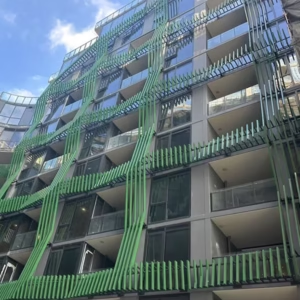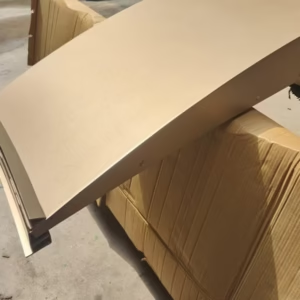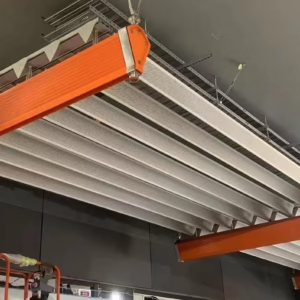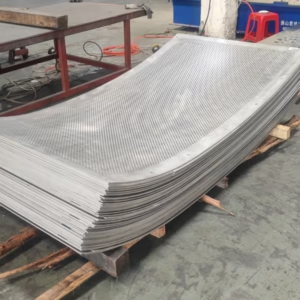Technologie de traitement, mesures d'assurance de la qualité et réception du cintrage des profilés de murs-rideaux
1. Techniques de traitement pour le cintrage des profilés de murs-rideaux

1.1 Sélection des matériaux
- Les alliages d'aluminium légers et très résistants sont généralement choisis en raison de leur excellente résistance à la corrosion et de leur stabilité de forme, ce qui les rend adaptés au cintrage.
1.2 Équipement et technologie de cintrage
- Des équipements de cintrage spécialisés, tels que des machines à commande numérique, sont utilisés pour améliorer la précision et l'efficacité du traitement. Au cours du processus de cintrage, des calculs et des ajustements précis sont effectués sur la base des dessins de conception afin de garantir que le degré et l'angle de cintrage des profilés répondent aux exigences.

1.3 Contrôle des paramètres du processus
- Cela comprend la conception du moule, le contrôle de la température et l'ajustement de la vitesse de pliage pour minimiser la concentration des contraintes, prévenir la déformation et éviter les fissures.
1.4 Traitement de surface
- Après le cintrage, la surface des profilés est traitée pour améliorer la résistance à la corrosion et l'esthétique.
2. Mesures d'assurance de la qualité
2.1 Gestion des équipements et des instruments de mesure
- Les équipements de transformation et les instruments de mesure doivent être régulièrement inspectés et étalonnés pour garantir la précision de la transformation.
2.2 Conception et optimisation des moules
- Les moules doivent être raisonnablement conçus pour éviter la déformation ou la fissuration des profilés au cours du processus de pliage.
2.3 Contrôle strict des paramètres du processus
- Grâce aux essais et à l'accumulation d'expérience, optimiser les paramètres du processus de cintrage, tels que le rayon de cintrage, la force de traction, etc., afin de minimiser le retour élastique et les écarts dimensionnels.
2.4 Surveillance de la qualité de surface
- Effectuer le traitement de surface des moules et utiliser des lubrifiants pour éviter les rayures et les indentations.
2.5 Cintrage segmenté et fixation du support
- Pour les profils larges ou complexes, adopter des méthodes de cintrage segmenté et utiliser des techniques de fixation des supports pour réduire les contraintes de déformation.

3. Transfert et acceptation
3.1 Inspection visuelle
- Inspecter la surface des profilés pour y déceler des défauts tels que des fissures, des plis ou des rayures, afin de s'assurer que leur apparence est intacte.
3.2 Mesure des dimensions
- Utiliser des outils de mesure pour mesurer les dimensions critiques telles que la longueur, l'angle et le rayon de courbure afin de confirmer la conformité avec les exigences de la conception.
3.3 Essai de résistance à la flexion
- Évaluer le comportement de déformation et les niveaux de contrainte des profilés pendant le processus de cintrage pour s'assurer que leur résistance au cintrage est conforme aux exigences.
3.4 Essai d'impact
- Évaluer la ductilité et la résistance aux chocs des profilés pour s'assurer qu'ils ne risquent pas de se casser ou d'être endommagés pendant l'utilisation réelle.
3.5 Inspection numérique
- Utiliser la technologie de numérisation 3D pour inspecter les profils, capturer les contours de la surface et les conditions de déformation afin d'améliorer la précision du traitement et le taux de réussite.
4. Problèmes communs et solutions
4.1 Rides et fissures
- Pour résoudre ces problèmes, il convient d'ajuster la forme du moule, d'augmenter la force de traction et d'optimiser les paramètres du processus.
4.2 Déformation de la section transversale et retour élastique
- Concevoir raisonnablement les moules, utiliser des méthodes de fixation des supports, estimer les quantités de retour élastique et appliquer la compensation.
4.3 Rayures de surface
- Effectuer le traitement de surface des moules, utiliser des lubrifiants et renforcer le contrôle opérationnel.
4.4 Questions relatives à la précision dimensionnelle
- Contrôler strictement les paramètres du processus, inspecter régulièrement les moules et renforcer les contrôles dimensionnels.
5. Conclusion
La technologie de traitement du cintrage des profilés de mur-rideau nécessite un contrôle strict sous de multiples aspects, notamment la sélection des matériaux, la gestion des équipements et le contrôle des paramètres du processus, afin de garantir la qualité et la précision du traitement. En outre, l'inspection numérique et les méthodes de contrôle de la qualité permettent d'améliorer encore la fiabilité du produit. Au cours de la phase de remise et d'acceptation, les inspections doivent être menées en stricte conformité avec les normes et spécifications pertinentes afin de s'assurer que les profilés répondent aux exigences de conception et aux normes d'utilisation.




